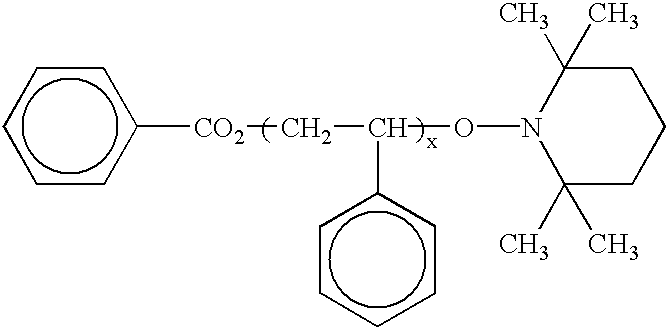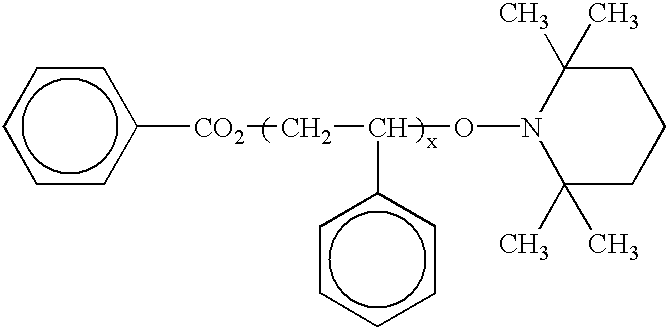Polymerization processes
a technology of polymerization process and polymerization method, which is applied in the direction of film/foil adhesive, transportation and packaging, special tyres, etc., can solve the problems of difficult to predict or control both the polydispersity and modality of the produced polymer, the prior art emulsion polymerization process is prone to generating excessive quantities of heat, and the dissipation of heat becomes more difficult, so as to achieve easy control of the modality and the residual mono
- Summary
- Abstract
- Description
- Claims
- Application Information
AI Technical Summary
Benefits of technology
Problems solved by technology
Method used
Image
Examples
example i
Semi-emulsion Polymerization--Partial Bulk Polymerization followed by Miniemulsion Polymerization
To a 100 ml round-bottom flask was added styrene (25 mL), TEMPO (0.195gm, 1.25 mmole), and benzoyl peroxide (BPO, 0.242 gm, 1.0 mmole). The solution was deoxygenated by bubbling argon through the solution for 20 minutes and then heated to 135.degree. C. by immersion in a preheated oil bath. The solution was maintained at temperature for 1 hour, cooled and the resulting latomer mixture was added to a solution of sodium dodecylbenzenesulfonate (SDBS, 3.1 g) in water (100 mL). This was then passed through a piston homogenizer for 30 seconds at about 1,000 bar or about 20,000 psi. The resulting white emulsion of the latomer mixture was then transferred to a 300 mL PARR reactor and then deoxygenated by pressurizing / depressurizing 10 times with argon gas. This was then heated to 135.degree. C. and maintained at that temperature for 6 hours to complete the polymerization of monomer and oligomer...
example ii
Semi-emulsion Polymerization--Bulk Polymerization Masterbatch Latomer Preparation
A large masterbatch of limited conversion bulk polystyrene was prepared by adding to a 2 liter round-bottom flask styrene (1 L), BPO (9.681 gm, 39.9 mmole) and TEMPO (7.808 g, 50.1 mmole). This was deoxygenated by bubbling argon through the solution for 40 minutes and then heated to 135.degree. C. for 1 hour. There resulted a latomer mixture containing about 95 weight percent monomer and about 5 weight percent polystyrene polymer of Mn=1,100, that is a 95:5 by weight mixture of monomer and styrene oligomer with a styrene conversion of about 5 percent by weight based on the total weight of the monomer.
example iii
Semi-emulsion Polymerization--Miniemulsion Polymerization
To a solution of SDBS (23 gm) in water (1 L) was added 300 ml of Example II. This was then microfluidized for 2 passes at 15,000 psi resulting in an emulsion. This was transferred to a 2 L PARR reactor and deoxygenated by pressurizing / depressurizing for 10 times with argon. This was then heated and maintained at 135.degree. C. for 6 hours. Upon cooling a stable emulsion polymer was isolated with particle size about 150 nm, Mn=19,300 PD=1.33 and residual monomer content of 2,400 ppm or about 0.2 weight percent and a conversion of about 99.8 weight percent based on the weight of monomer. The resulting latex emulsion was found to be unexpectedly stable against particle separation at room temperature, for example, from about 20 to about 30.degree. C., for at least 8 months and expectedly longer.
PUM
| Property | Measurement | Unit |
|---|---|---|
| polydispersity | aaaaa | aaaaa |
| temperature | aaaaa | aaaaa |
| temperature | aaaaa | aaaaa |
Abstract
Description
Claims
Application Information
 Login to View More
Login to View More - R&D
- Intellectual Property
- Life Sciences
- Materials
- Tech Scout
- Unparalleled Data Quality
- Higher Quality Content
- 60% Fewer Hallucinations
Browse by: Latest US Patents, China's latest patents, Technical Efficacy Thesaurus, Application Domain, Technology Topic, Popular Technical Reports.
© 2025 PatSnap. All rights reserved.Legal|Privacy policy|Modern Slavery Act Transparency Statement|Sitemap|About US| Contact US: help@patsnap.com


